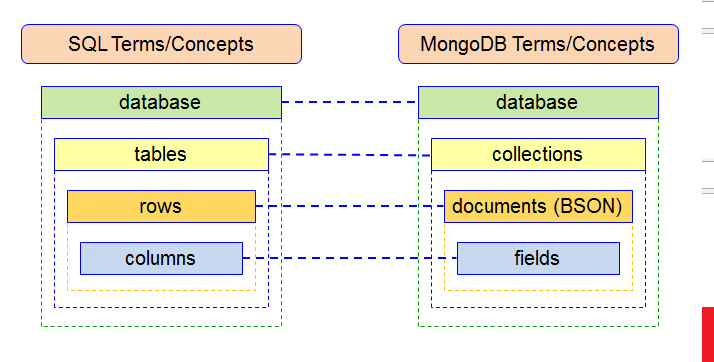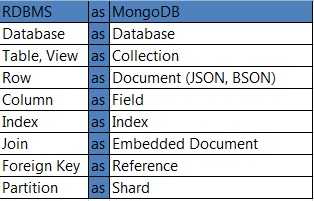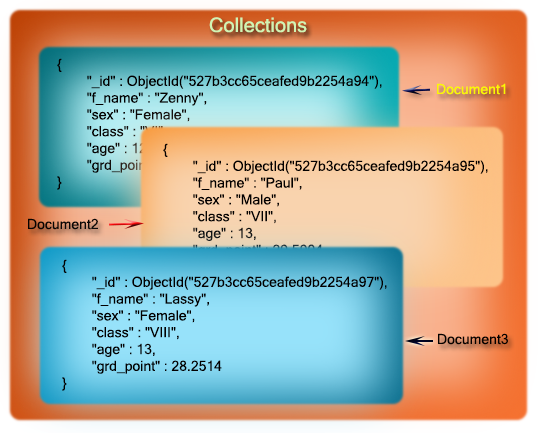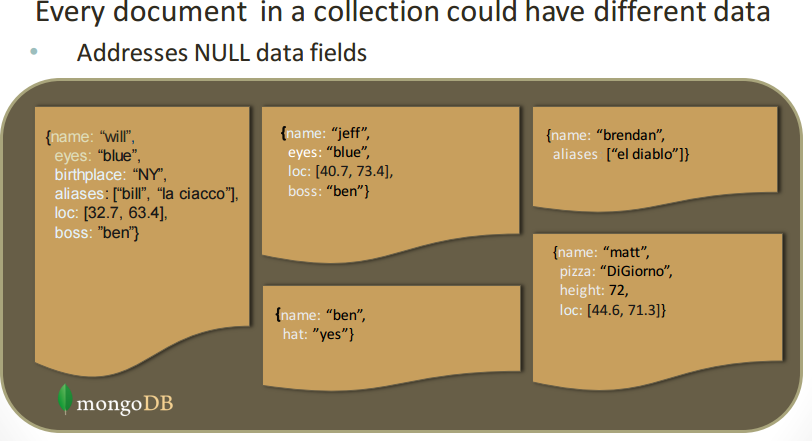|
CS6320: SW Engineering of Web Based Systems |
||||||
|
MongoDB - a quick look
-
NO SQL "database" or sometimes called a "document" database
Leveraging your knowledge of traditional databases
-
collection = like database table
document = entry /row in collection = like database row
field = like a column but, --there is no ordering or notion of required
field _id = primary key




Each document can have different fields of data!!!

A note about the special field _id
every document in a collection will be assigned a unique value of _id.
it is like it's primary key
Some andedotal pros/cons of a Document Database (like MongoDB) over a Relational Database (like Oracle, MySQL)
Pros of Document Database |
Cons of Document Database |
|
|
|
|
|
|
| Applications that require complex, multi-row transactions (e.g., a double-entry bookkeeping system) |
Mongoose in MongoDB --adding more structure --to make program reliability better?
"provides elegant MongoDB object modeling for Node.js"
MongoDB and NodeJS
Connecting
var mongodb = require('mongodb');// Standard URI format: mongodb://[dbuser:dbpassword@]host:port/dbname // GO TO mLab.com account to see what YOUR database URL is //CHANGE the url so it is correct for your account var uri ='mongodb://YOUR_LOGIN:YOURPASSWROD@WHATEVER.mlab.com:xxxxx/dnName';//using mongodb module mongodb.MongoClient.connect(uri, function(err, db) {if(err) throw err; // NOW DO WHAT YOU WANT -- CRUD }CRUD - data manipulation (Create Read Update Delete) -- read mongoDB site for more including bulk writes
//INSERT -like create
// Insert a single document
var r = yield db.collection('inserts').insertOne({a:1});assert.equal(1, r.insertedCount);
// Insert multiple documents
var r = yield db.collection('inserts').insertMany([{a:2}, {a:3}]);assert.equal(2, r.insertedCount);
//FIND -like read // Get first two documents that match the query
// Get the collection
var col = db.collection('find'); var docs = yield col.find({a:1}).limit(2).toArray(); assert.equal(2, docs.length);//option 2 Find // Get the cursor var cursor = col.find({a:1}).limit(2); // Iterate over the cursor while(yield cursor.hasNext()) { var doc = yield cursor.next(); console.dir(doc); }
//UPDATING
/// Get the updates collection
var col = db.collection('updates');
// Insert a single document
var r = yield col.insertMany([{a:1}, {a:2}, {a:2}]);
assert.equal(3, r.insertedCount);
// Update a single document
var r = yield col.updateOne({a:1}, {$set: {b: 1}});
assert.equal(1, r.matchedCount);
assert.equal(1, r.modifiedCount);
// Update multiple documents
var r = yield col.updateMany({a:2}, {$set: {b: 1}});
assert.equal(2, r.matchedCount);
assert.equal(2, r.modifiedCount);
//DELETING documents
// Get the removes collection
var col = db.collection('removes');
// Insert a single document
var r = yield col.insertMany([{a:1}, {a:2}, {a:2}]);
assert.equal(3, r.insertedCount);
// Remove a single document
var r = yield col.deleteOne({a:1});
assert.equal(1, r.deletedCount);
// Delete multiple documents
var r = yield col.deleteMany({a:2});
assert.equal(2, r.deletedCount);
//FIND AND UPDATE OR FIND AND DELETE
// Modify and return the modified document
var r = yield col.findOneAndUpdate({a:1}, {$set: {b: 1}}, { returnOriginal: false , sort: [[a,1]] , upsert: true });
assert.equal(1, r.value.b);
// Remove and return a document
var r = yield col.findOneAndDelete({a:2});
assert.ok(r.value.b == null);
// Close connection
db.close();